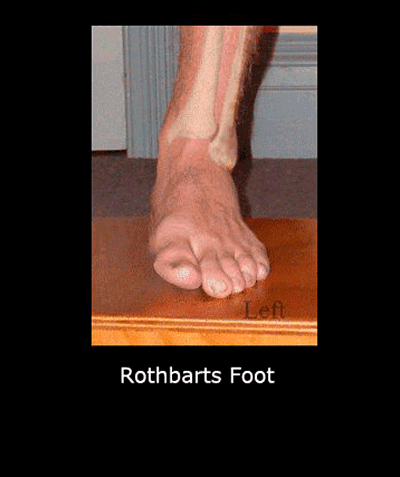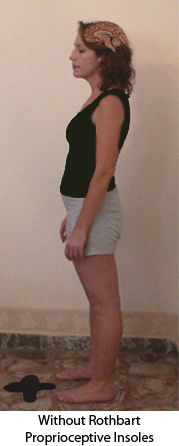Positive Health Online
Your Country

Twisting Foot and Musculoskeletal Pain: Root's Biomechanical Model vs Rothbart's Neurophysiological Model
by Brian A Rothbart PhD(more info)
listed in bodywork, originally published in issue 186 - September 2011
Introduction
There are two distinct theoretical models that describe the pathomechanics, in a step by step fashion, that link a twisting foot to the development of chronic musculoskeletal pain: the BioMechanical Model and the Neurophysiological Model. Both models predict postural distortions, compensatory hypertonicity and a lifelong struggle with musculoskeletal pain. However, depending on which model the clinician ascribes to, determines the type of orthotic or insole used to treat a twisting foot: supportive orthotics or proprioceptive insoles.
The BioMechanical Model
The BioMechanical Model was first introduced by Root[1] in the mid 1950s to explain lower body mechanics and then later expanded by Rothbart[2] to include upper body mechanics. The BioMechanical Model is based on Newtonian physics (all objects, unless otherwise prevented, fall to mother earth) and basic engineering principles (so goes the foundation, so goes the roof).
In a strong gravitational field, certain abnormal foot structures (such as the structurally elevated first ray in Rothbarts Foot) force the weight bearing foot to roll inward, forward and downward (hyperpronate or twist) until the inside of the front part of the foot rests on the ground (See Diagram 1 - Foot Twist). This hyperpronation or foot twist shifts the body's center of gravity forward and downward. This shift in the body's COG pulls the hip bones forward and downward (anteriorly). When this anterior rotation of the hip bones is asymmetrical, the sacrum tilts.[3]
Tilting of the sacrum, if severe enough, distorts (augments) the natural spinal curves. As these distortions cascade up the spinal framework, scoliotic and kyphotic curves increase and become unstable. Typically, the head moves anteriorly relative to the cervical spine (e.g., forward head position), which thrusts the maxilla forward (Class II Malocclusion).[4]
This gravity-induced skeletal 'collapse' was originally termed BioImplosion,[5] but now is more commonly referred to as a kyphotic posture.
To reverse the kyphotic posture resulting from a twisting foot, the Biomechanical Model suggests that rigid or semi-rigid orthotics must be used to support the arches of the feet. This is much like an engineer would shim the foundation of a building to level the roof. This axion belies the effectiveness of the newer generation of proprioceptive insoles which do not support the feet, but which do reverse the distorted postures resulting from twisting feet.
The observed effectiveness of non-supporting type insoles in reversing postural distortions, led to the development of the Neurophysiological Model
The Neurophysiological Model
Rothbart[6] suggests that a neurophysiological pathway exists between the bottom of the feet and cerebellum. This neurophysiological pathway, in large part, determines the posture of the body:
- The plantar surfaces of both feet are embedded with millions of fast acting Meissner (touch activated) corpuscles;
- While standing or walking, at any given moment, certain areas of the feet are touching the ground;
- The Meissner corpuscles in the areas of the feet touching the ground are activated, forming a pattern of stimulation;
- This pattern of stimulation sends a signal to the brain, which the cerebellum uses to determine the position of the body in space (e.g., its posture);
- Acting on these signals, the cerebellum makes continuous micro-adjustments in the body's posture to maintain upright stability.
Rothbart has found that in a twisting foot (e.g., The Rothbarts Foot or the PreClinical Clubfoot Deformity), the patterns of stimulation are changed (distorted) compared to the patterns of stimulation in a non-twisting foot:
- In a twisting foot, the Meissner's corpuscles are stimulated along the outside of the heel and the inside of the ball of the foot (e.g., a distorted pattern of stimulation);
- In a non-twisting foot, the Meissner's corpuscles are stimulated evenly across the heel and the ball of the foot (e.g., a non-distorted pattern of stimulation).
Rothbart suggests that distortion patterns of stimulation result in distorted signals being sent to the cerebellum. The cerebellum responds to these distorted signals by placing the body into a distorted posture. (See Diagram 2 - Postural Shift).
The neurophysiological model was introduced by Rothbart in 2002, because the biomechanical model did not explain what he was seeing clinically, through his use of proprioceptive insoles. That is, by applying proprioceptive (non supporting) stimulation under the feet, dramatic, positive postural changes were achieved.
The Neurophysiological Model suggests that the only way to effectively and permanently eliminate chronic muscle and joint pain resulting from foot twist, is to permanently improve the posture. This is accomplished by using non-supportive proprioceptive insoles, which change the distorted patterns of stimulation to a non-distorted pattern. Corrected signals are then sent to the cerebellum, which automatically responds by aligning the posture into a more erect position.
Conclusion
As logical and intuitive as the BioMechanical Model sounds, it is inconsistent with the dramatic postural improvements observed when using non-supportive type insoles (e.g., proprioceptive insoles) underneath the feet.
This inconsistency in the BioMechanical Model led to the development of the Neurophysiological Model; a more inclusive model, which does explain how a non-supportive (proprioceptive) insole can change posture globally.
References
1. Root ML, Orien WP, Weed JH. Normal and Abnormal Function of the Foot. Clinical Biomechanics Corp., Los Angeles, CA. 1977.
2. Rothbart BA, Esterbrook L. Excessive Pronation: A Major Biomechanical Determinant in the Development of Chondromalacia and Pelvic Lists. Journal Manipulative Physiologic Therapeutics 11(5): 373-379. 1988.
3. Rothbart BA. Relationship of Functional Leg-Length Discrepancy to Abnormal Pronation. Journal American Podiatric Medical Association 96(6): 499-507. 2006.
4. Rothbart BA. Vertical Facial Dimensions Linked to Abnormal Foot Motion. Journal American Podiatric Medical Association, 98(3):01-08. May 2008.
5. Rothbart BA, Yerratt M. An Innovative Mechanical Approach to Treating Chronic Knee Pain: A BioImplosition Model. The Pain Practitioner (formerly American Journal of Pain Management) 4(3):13-18. 1994.
craniomandibular disorders and poor posture. Cranio April 18(2):106-12;2000.
6. Rothbart B A, Penzabene L F. Forever Free From Chronic Pain. 2nd Ed., Happy About
Publishers, California. 2009.
Comments:
-
No Article Comments available